July 3-6, 2018
Alaska Highway, Milepost 1523
The Alaska Highway from Tok to Fairbanks was not only scenic, it was informative as well. We stopped at a scenic viewpoint to take pictures of the Alaska Range and found panels on the Alaska Highway, early hunters of the Tanana River, and Slim Williams.
When Alaska Road Commissioner Donald MacDonald heard that Clyde “Slim” Williams was mushing from Alaska to the Chicago Worlds Fair he was delighted. It was perfect for promoting his idea for a highway linking Alaska with the lower 48. He wired Slim at one of his stops, asking him to place a banner on his sled and become a spokesman for the proposed road. Slim arrived at the Chicago World’s Fair in September 1933 after 10 months en route. Slim Williams and his dogs gained immense popularity at the fair by giving rides to fairgoers. First Lady Eleanor Roosevelt was so impressed with her ride, she invited Slim to Washington, D. C. to meet President Franklin D. Roosevelt.
We had learned about the importance of World War II in getting a road to Alaska, and Roosevelt’s exposure to Slim Williams may have influenced Roosevelt’s decision to build the road. Slim Williams went on to ride a motorcycle back to Alaska in 1939, “figuring it out” as he went on any path or trail he could find.
The Alaska Range, visible to the south as we traveled, is the third highest mountain range in the world after the Himalayas and Andes.
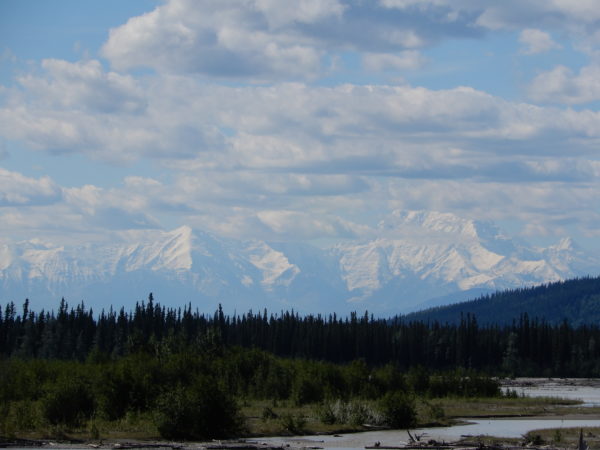
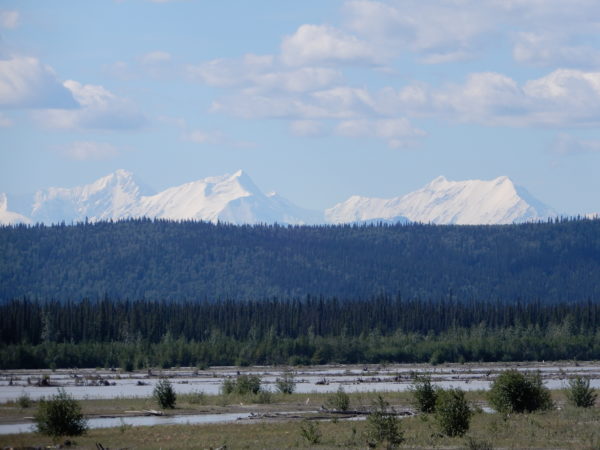
Mount Hayes 13,832 ft, Hess Mountain 11,940 ft, Mount Deborah 12,339 ft.
The Alaska Highway roughly parallels the Tanana River which flows northwest for almost 600 miles, starting near the Alaska-Yukon border and emptying into the Yukon River west of Fairbanks. Our route included several crossings of the river and its tributaries.
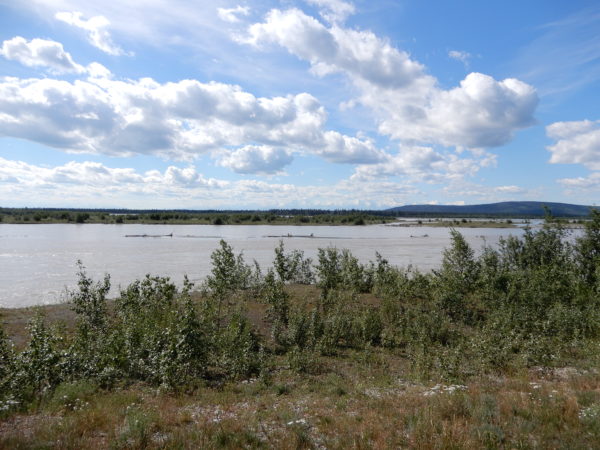
About halfway between Tok and Fairbanks is Delta Junction. It is here that the Alaska Highway joined with the Richardson Highway which in turn joined Fairbanks with the lower 48 states so supplies and troops could travel by land. Most travelers, including us, choose Fairbanks as the northern end of a journey to Alaska.
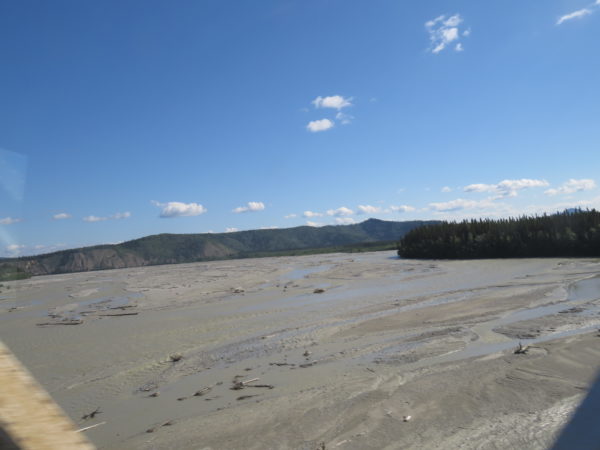
Tanana River
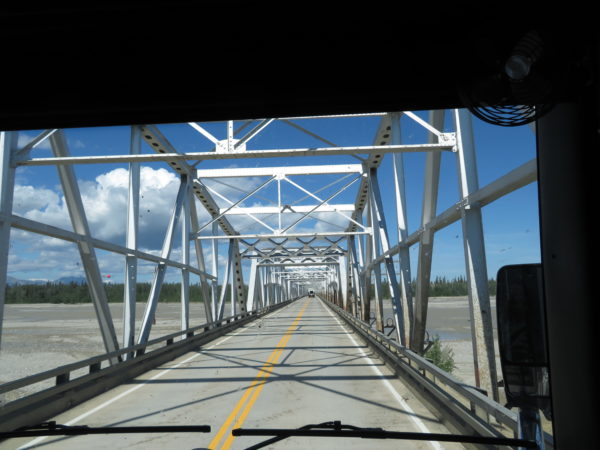
The Gerstle River Black Veterans Memorial Bridge commemorates the 3,695 African American soldiers for their contribution in constructing the Alcan Highway.
Our campground for Fairbanks was just outside of town in North Pole, Alaska. The town had its beginnings when a development company bought a homestead, subdivided it and named it North Pole, hoping to attract a toy manufacturer who could advertise products as being made in North Pole. The city incorporated in 1953 and developed a themed city “where the spirit of Christmas lives year round”. The city’s light poles are painted to look like candy canes and the street names include Santa Claus Lane, St. Nicholas Dr., and Mistletoe Drive. The city’s major attraction is the Santa Claus House which is the home of the Original Letter from Santa. Cards and letters mailed here have an authentic North Pole postmark. Santa is here year round and his reindeer are next door at the Antler Academy of Flying and Reindeer Games.
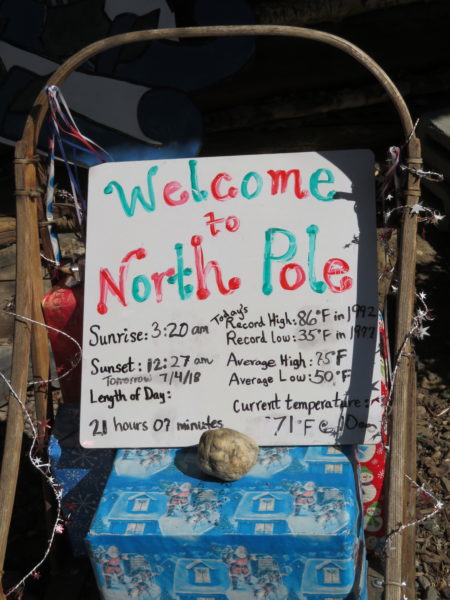
Note the sunrise and sunset times.
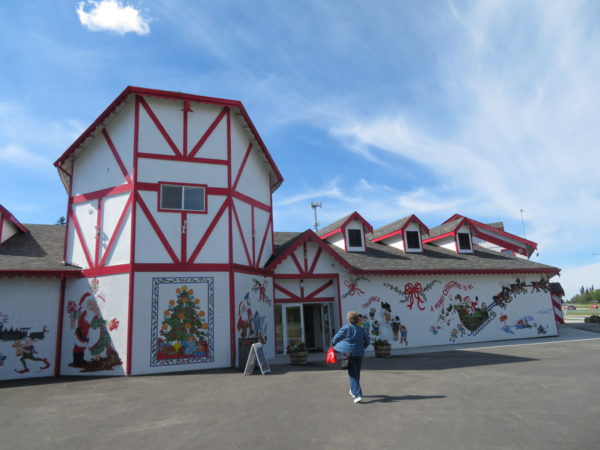
Santa Claus House
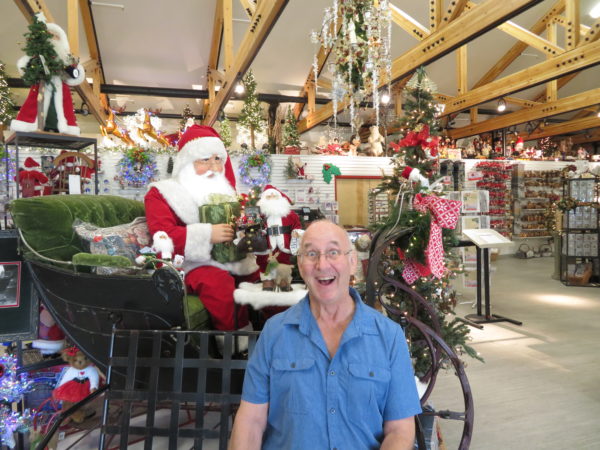
Dave was very excited.
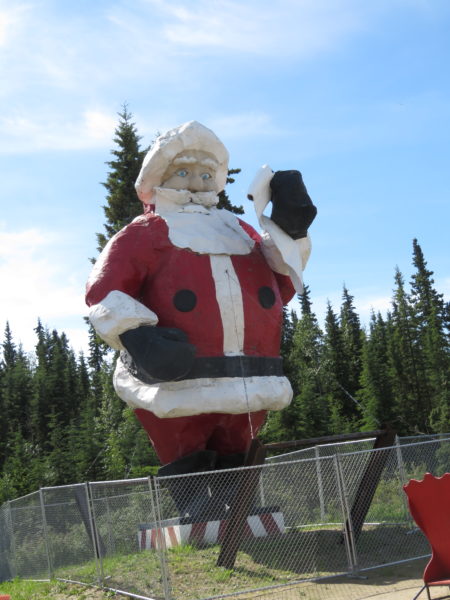
Santa is 43 feet tall.
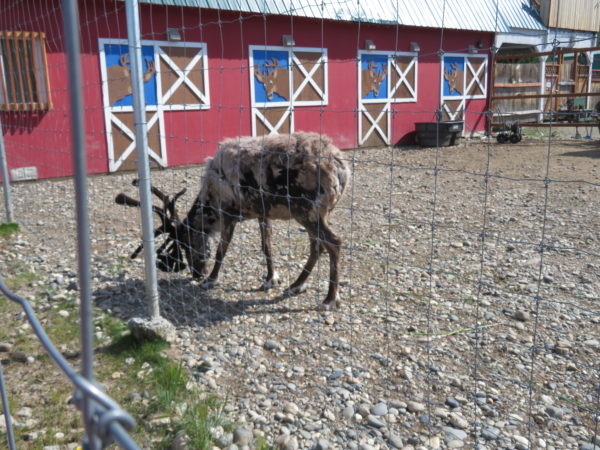
Shedding Reindeer are not very attractive, nor do they smell nice.
Fairbanks is Alaska’s third largest city with a city population of about 32,000 and an area population of almost 100,000. It lies on the forested valley floor of the Chena River near its confluence with the Tanana.
The town’s beginning happened through a series of unplanned events. Captain E. T. Barnette was traveling up the Yukon River by sternwheeler with the intent to set up a trading post at Tanacross, the point where the Tanana River crosses the halfway point on the trail from the Port of Valdez to the gold fields in Eagle, Alaska. Low water in the Tanana River forced the sternwheeler’s captain to put Barnette and his supplies ashore at the Chena River. Barnette opened a temporary trading post right there, intending to move on to Tanacross the next summer. The following year Felix Pedro, an Italian prospector, discovered gold about 16 miles north of the trading post and Barnette abandoned his plans to move as more prospectors flooded in. The name Fairbanks had been suggested by District Judge James Wickersham who admired Charles W. Fairbanks, the senior senator from Illinois who went on to become Vice-President under Theodore Roosevelt. That fall Barnette helped convince the 25 or so miners in the area to use the name “Fairbanks” for the town he expected would grow up around his trading post. The town grew with additional discoveries and Barnette’s promotion of the area, and in 1903 Judge Wickersham moved the headquarters of his Third Judicial District Court from Eagle to Fairbanks. Thanks to Wickersham, the town gained government offices and a jail. Thanks to Barnette, it gained a post office and the Northern Commercial Company, a trading firm based in San Francisco. The town incorporated and Barnette became the first mayor of Fairbanks in 1903. It acquired telephone service, set up fire protection and contracted for sanitation, electric lights, and steam heat. Barnette started a bank in 1904 and by 1910 Fairbanks had a population of 3,541.
We started our exploration Fairbanks at the Morris Thompson Cultural and Visitor Center, the most complete and informative Visitor Center we have encountered. The center has several rooms of exhibits on interior Alaska history, culture, nature, and people. It had a theater with different films throughout the day, an Alaska Public Lands Information Center staffed by the U.S. Parks Service, and the Tanana Chiefs Cultural Programs which included talks, demonstrations and indigenous song and dance performances.
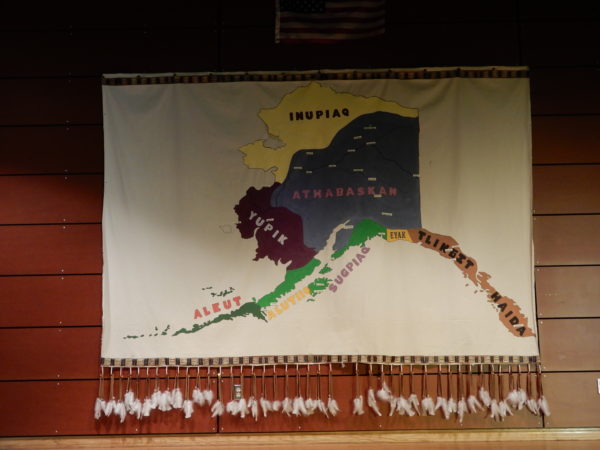
Indigenous cultures of Alaska
The center is located on the banks of the Chena River, and outside it had bike paths, walks, mosaics and a 1905 pioneer cabin still on its original site.
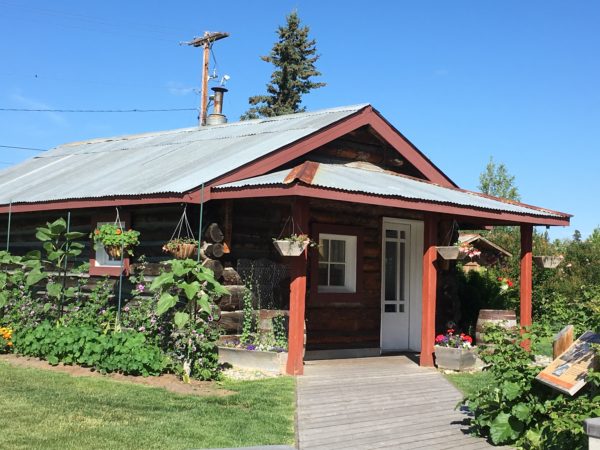
The Center had much more than the usual brochures of attractions that we spent half a day exploring it. The Parks Center even had a mystery geocache treasure hunt for Dave that required him to find clues in 16 different locations through the exhibits, decode a cryptogram, and find a hidden geocache from the clues. Spoiler alert: The final cache was hidden in a hollow log in the wood bin on the cabin’s porch.
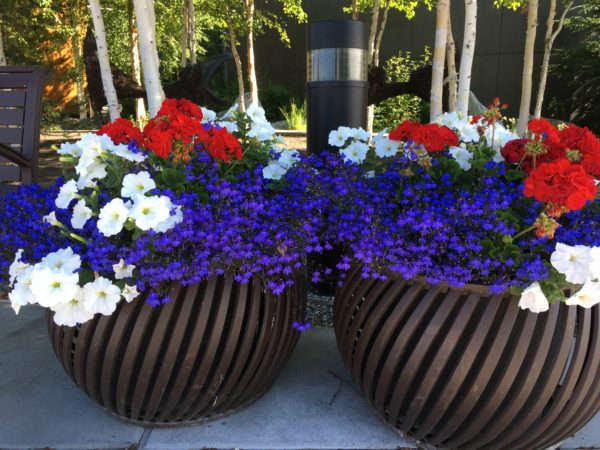
Holiday-themed flowers outside the visitors center
Next on the agenda was to take in the Fourth of July celebration at Pioneer Park. The park is home to many of Fairbanks’s early cabins and buildings which were moved to this location when the Alaska ’67 Centennial Exposition was held here. It marked the 100 year anniversary of the purchase of Alaska from Russia. Some of the attractions in the park include the Pioneer Museum, the Tanana Valley Railroad Museum, an air museum, Judge Wickersham’s house, and the SS Nenana sternwheeler as well as shops, restaurants and games and activities for kids.
The Fourth of July celebration started with a flag presentation, the Pledge of Allegiance, and the National Anthem followed by speeches by the governor, mayor and other dignitaries from the military and government. This was followed by a kid’s parade led by the Fairbanks Red Hackle Pipe Band and Smoky the Bear! There were costume contests and music at several venues throughout the day. What this Fourth of July did not have was fireworks because in Fairbanks at this time of year it never gets dark. From about mid-June through mid-July it really is the land of the midnight sun. The sun does dip below the horizon for a couple of hours, but the twilight is bright enough to see without artificial lighting.
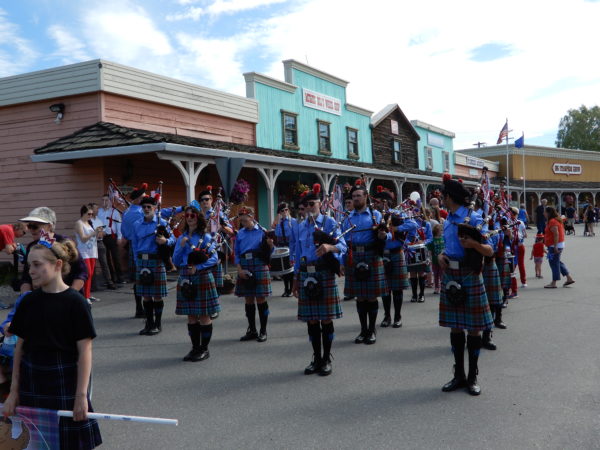
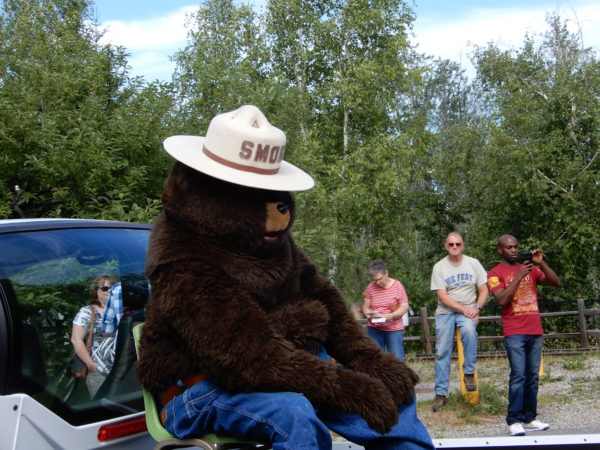
We finished our day with a trip to the Fairbanks Ice Palace. Housed in an old movie theater, it starts with a movie about the ice sculpting competition held each winter in Fairbanks. We then donned heavy parkas and entered a part of the building that was chilled to 20º below zero and held ice sculptures from previous competitions. We sat on a snow machine made of ice, an ice sleigh and even tobogganed down an ice hill indoors while the outside temperature was about 65º.
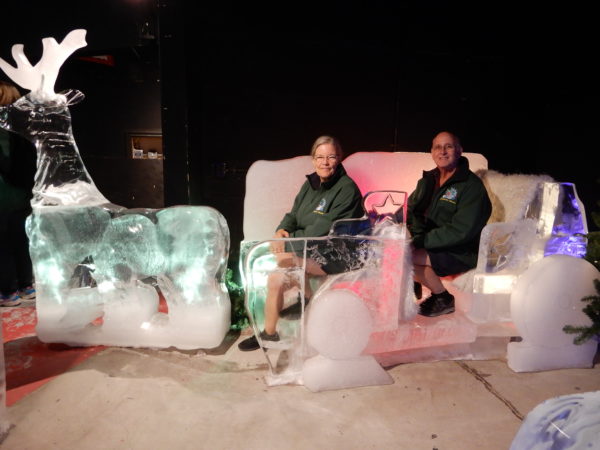
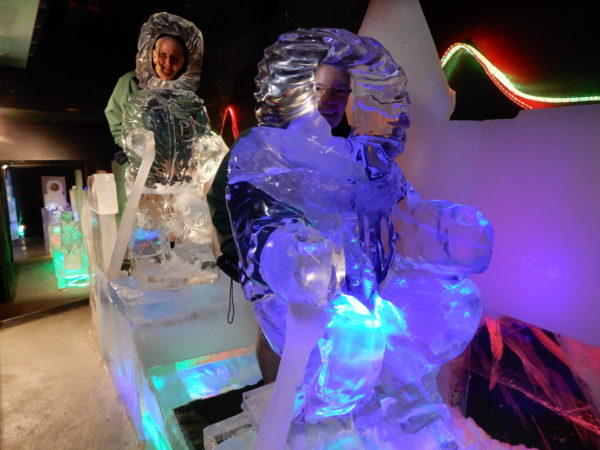
A walk in downtown Fairbanks and an espresso at a coffee shop afterward warmed us up before we headed back to the RV.
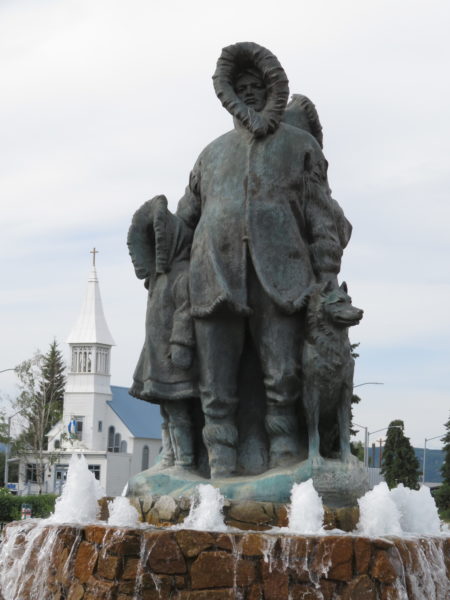
“Unknown First Family” sculpture in downtown Fairbanks
The next day, like Captain Barnette who helped found Fairbanks, we took a sternwheeler to the confluence of the Tanana and Chena Rivers.
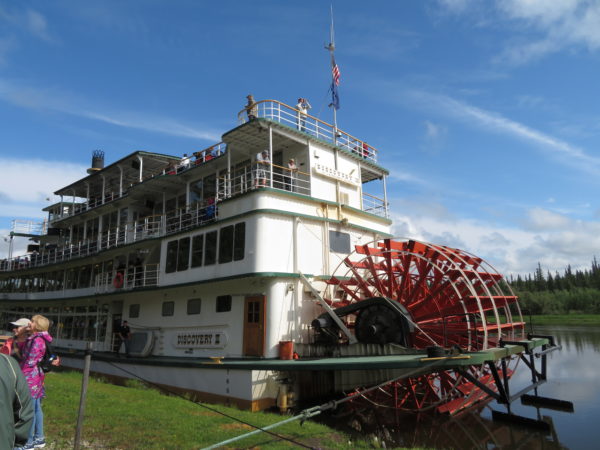 The Riverboat Discovery III is owned and operated by the Binkley family who for five generations have been riverboat pilots in Alaska. The Discovery is 156 long, has a 34-foot beam, and holds 900 passengers. Shortly after leaving the dock and admiring the scenery and homes on the river, a float plane came along the side of the ship and demonstrated take-offs and landings for us.
The Riverboat Discovery III is owned and operated by the Binkley family who for five generations have been riverboat pilots in Alaska. The Discovery is 156 long, has a 34-foot beam, and holds 900 passengers. Shortly after leaving the dock and admiring the scenery and homes on the river, a float plane came along the side of the ship and demonstrated take-offs and landings for us.
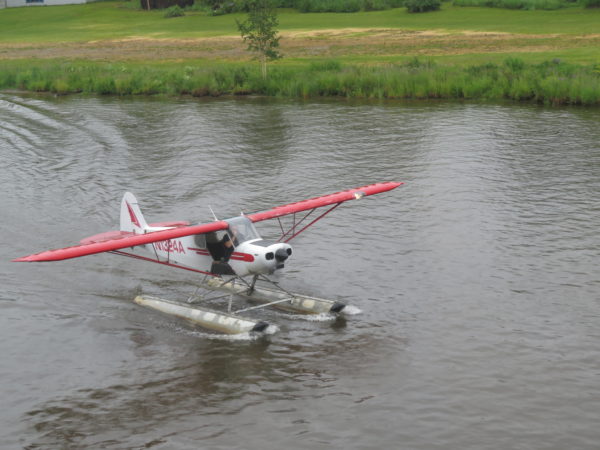
Further downriver we came to the sled dog kennel and training facility established by Susan Butcher, the woman who won the 1,100 mile Iditarod race four times. Trainers brought out some of the young dogs (aww) and a team of veteran dogs pulled a trainer around the property on an ATV. The dogs were rewarded with food and by being allowed to play in the river.
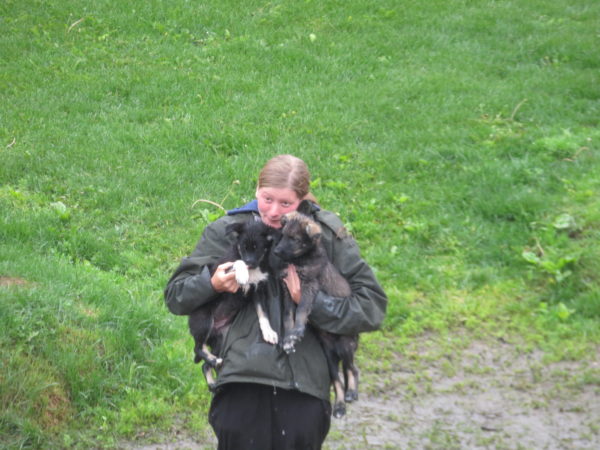
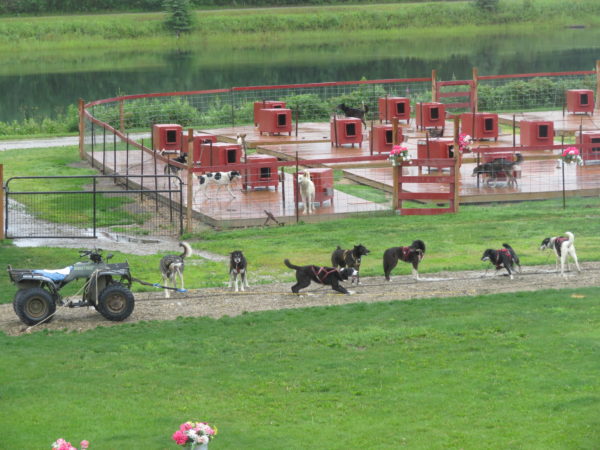
We continued to our next stop where we disembarked and Alaska native guides took us on a tour of a Chena Indian village which included demonstrations of native costumes, hunting and trapping, raising sled dogs and caribou, and processing and smoking salmon, as well as sharing stories of their history and culture.
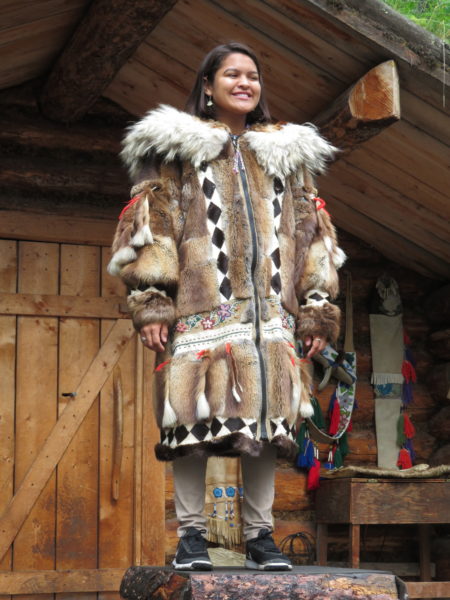
Pretty Athabaskan girl wearing a ceremonial parka.
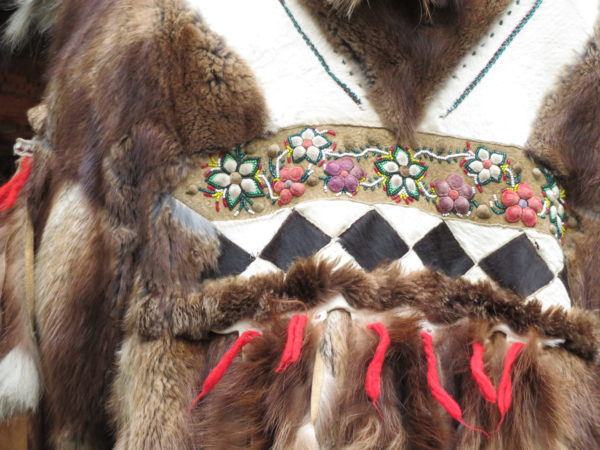
Back of the parka.
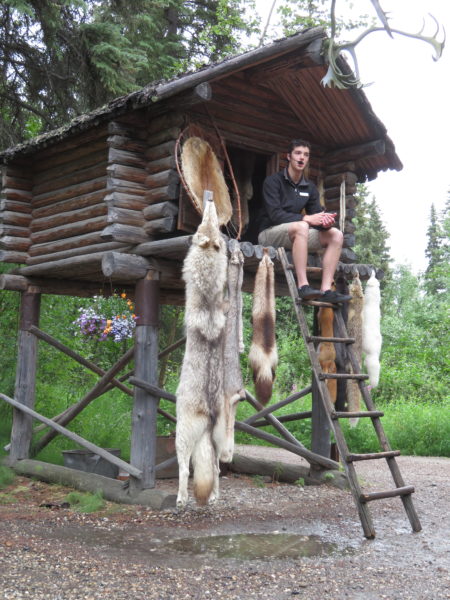
Native furs and a food storage cache.
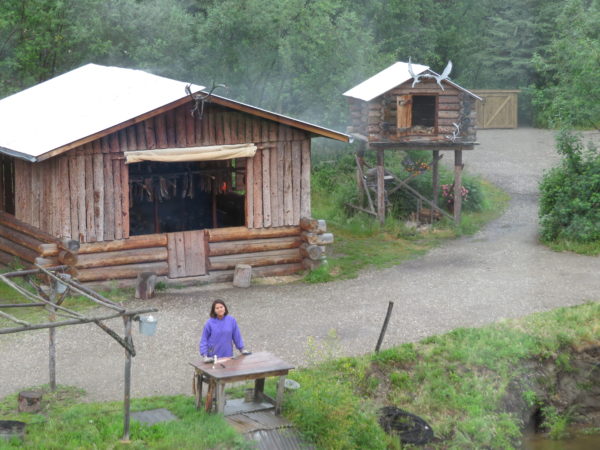
Processing salmon by the smokehouse.
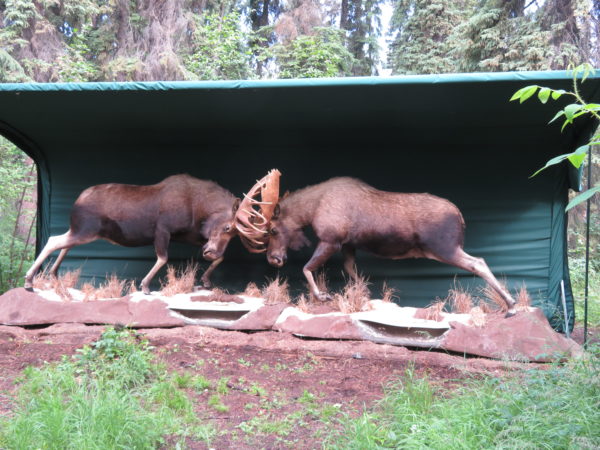
These moose were discovered frozen with their horns locked together.
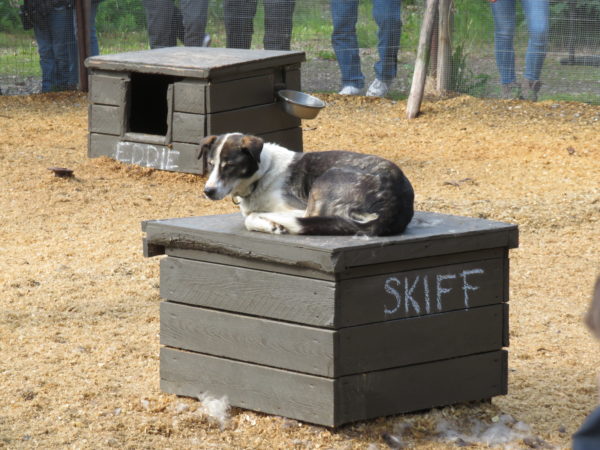
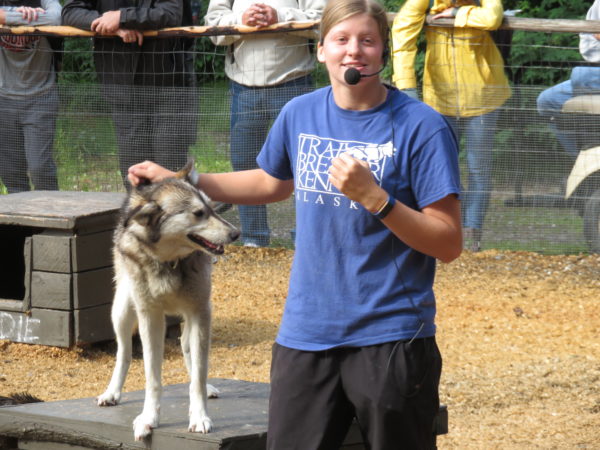
Following our riverboat tour, we went to the Museum of the North at the University of Alaska. The museum’s Gallery of Alaska was divided into sections focusing on the cultures, wildlife, geography, and history of each of Alaska’s five major geographic regions. The western Arctic coast includes the Inupiaq and Yupik groups, the interior is Athabascan, the southwest is Aleut and Alutiiq, and the south-central is Tlingit, Haida and Tsimshian cultures. The museum also had an interesting Alaskan art gallery.
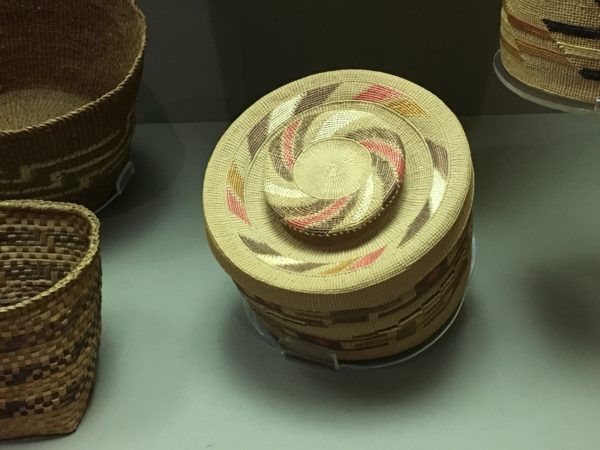
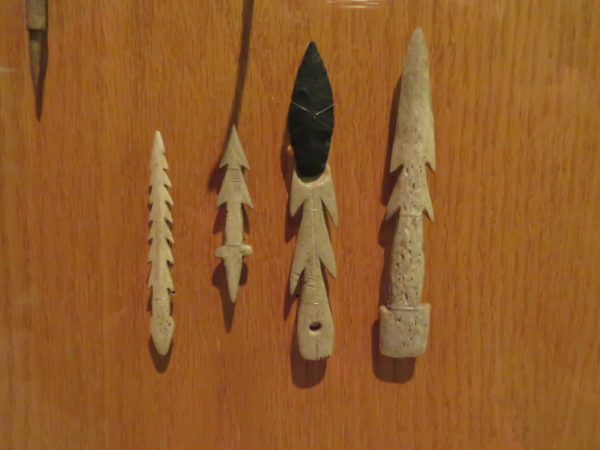
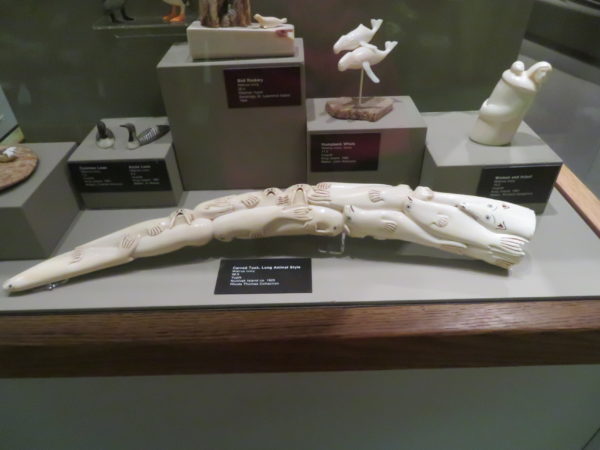
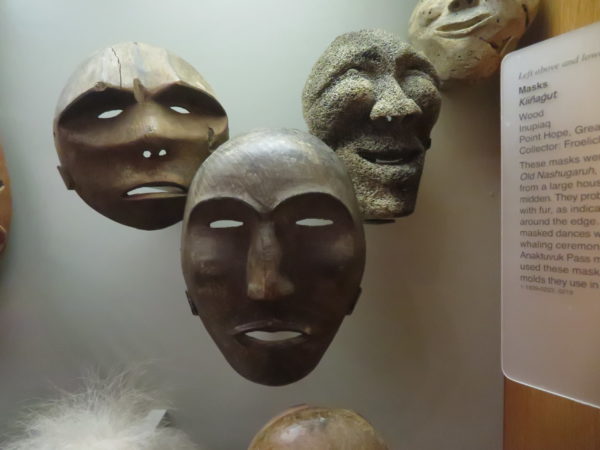
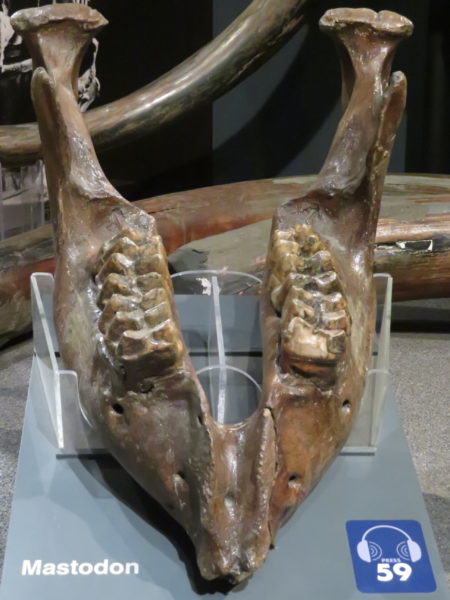
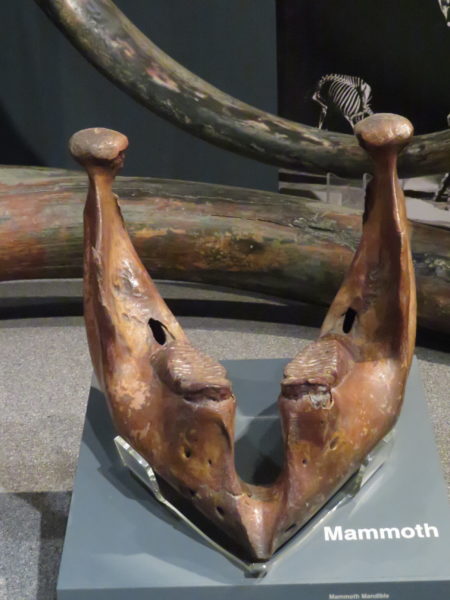
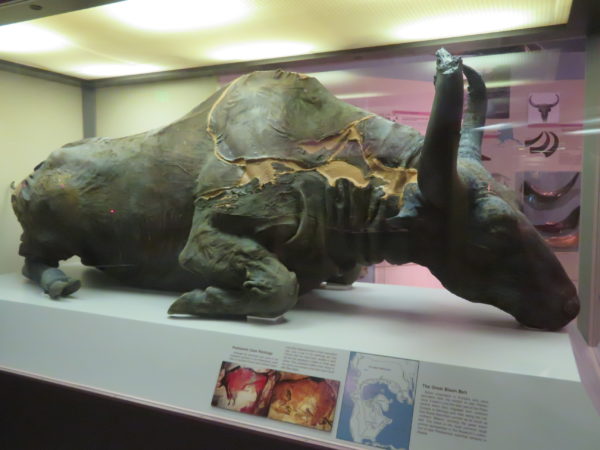
This is a Steppe Bison that was killed by an American Lion 36,000 years ago, quickly covered by sediment and frozen in permafrost preserving the body. It was discovered by placer miners north of Fairbank.
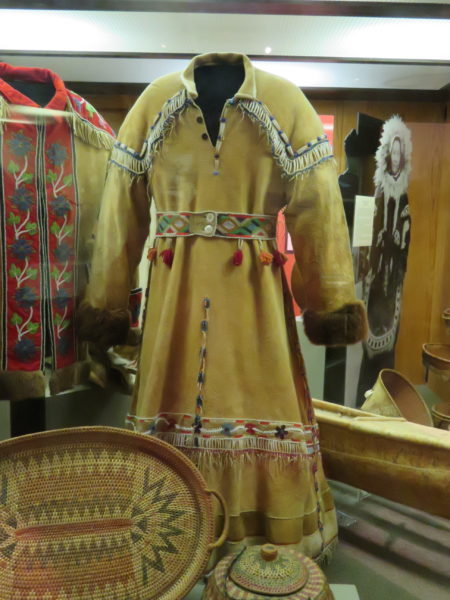
We drove out to the University’s Large Animal Research Station so we could see and take pictures of the musk ox there. We remembered from our visit to the Beringia Interpretive Center that musk ox have been in this area since the Ice Age.
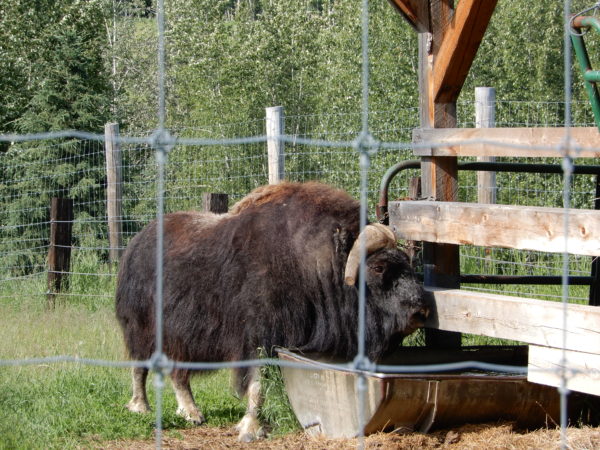
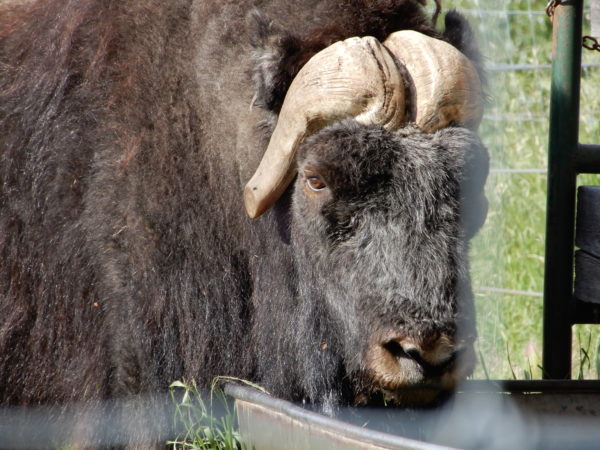
The tips of the horn were removed for the researchers’ and animals’ safety.
The second tour we took in Fairbanks was a trip to the gold fields north of town where Dredge No. 8 is located. This adventure began with a close-up view of the Trans-Alaska Pipeline where we learned about its construction and history. The information about how they dealt with permafrost and making it wildlife-friendly was especially interesting.
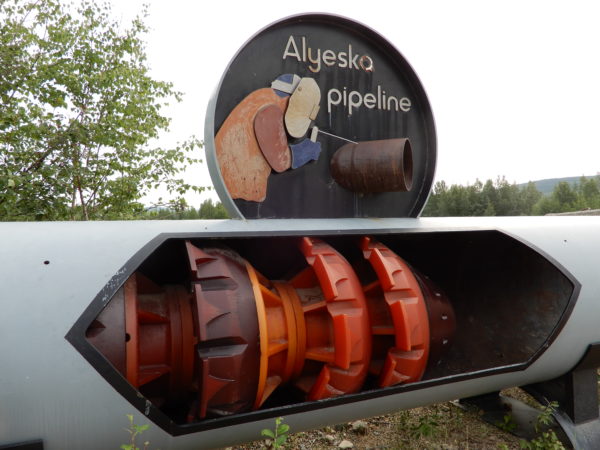
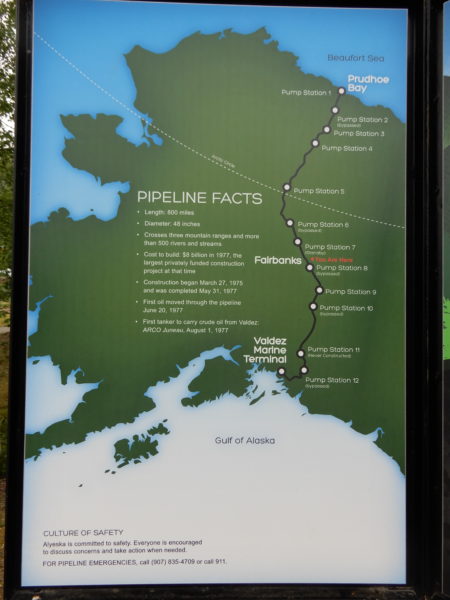
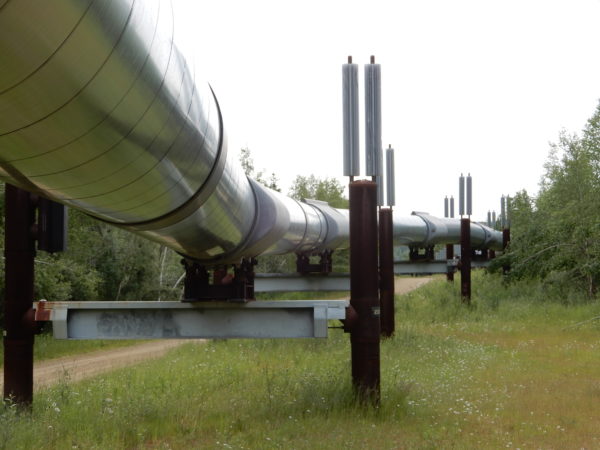
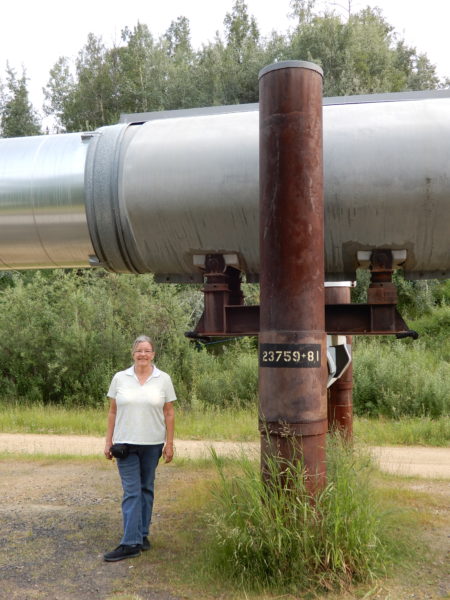
Jane providing scale.
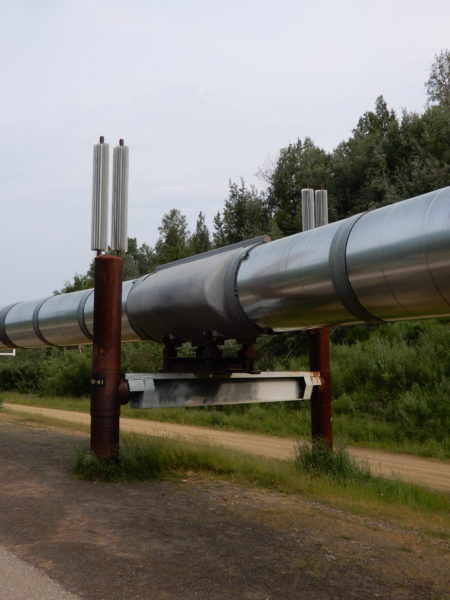
The structures beside the pipeline are Heat Pipes. These self-contained passive refrigeration devices contain carbon dioxide or anhydrous ammonia which transfer ground heat into the air when the air temperature is cooler than the ground. This heat transfer process “super chills” the ground ensuring that unstable soils remain frozen year-round to support the pipeline. There are more than 124,000 heat pipes along the pipeline.
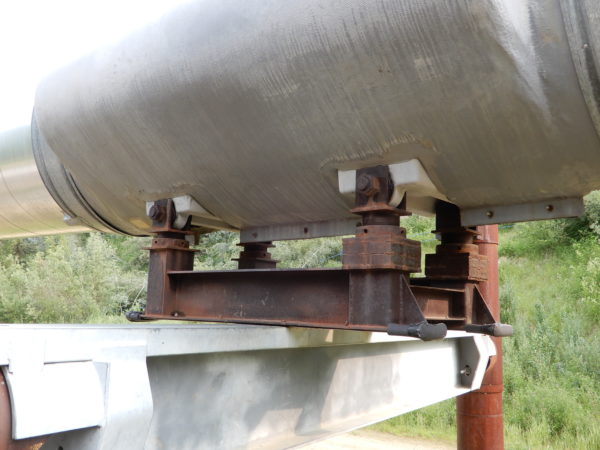
Above ground sections or the pipeline are built in a zigzag configuration to allow for expansion or contraction of the pipeline due to temperature changes. This also allows for movement of the pipeline during an earthquake, with a greater allowance for lateral or vertical movement at major fault lines. The pipeline rests on the support structures without being directly attached to them.
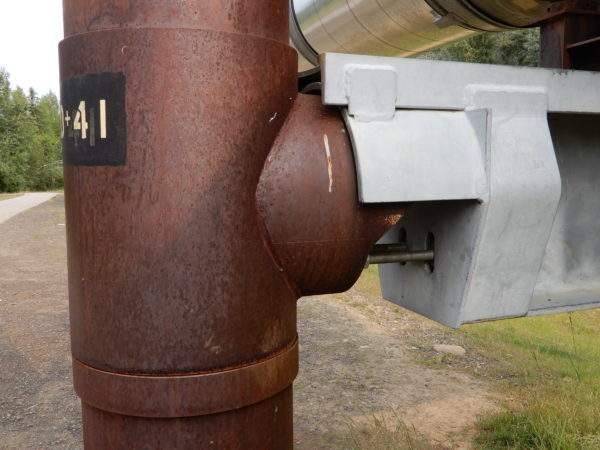
The support structures can also move independently from the pipeline and each other.
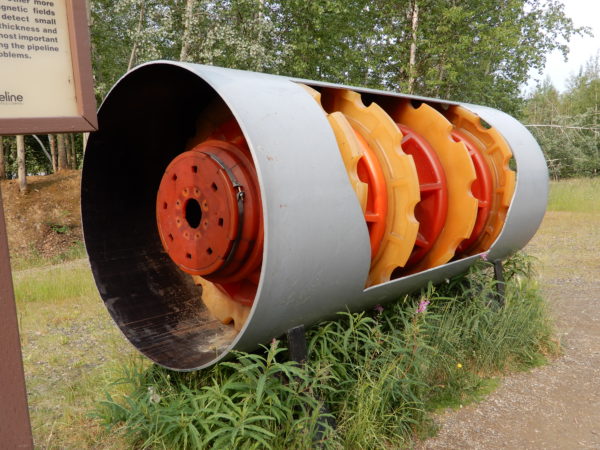
Devices called “pigs” improve the flow of oil in the pipeline and monitor its condition. Pigs are launched and retrieved at pump stations and travel with the moving oil. They keep the pipe clean and can detect any changes in the condition of the pipes.
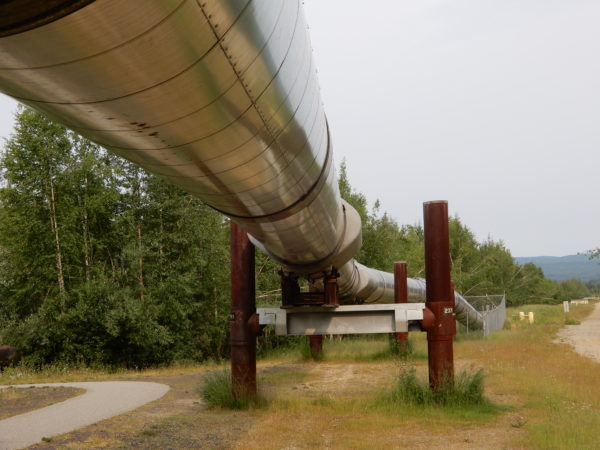
The pipeline goes back underground after crossing the area of permafrost.
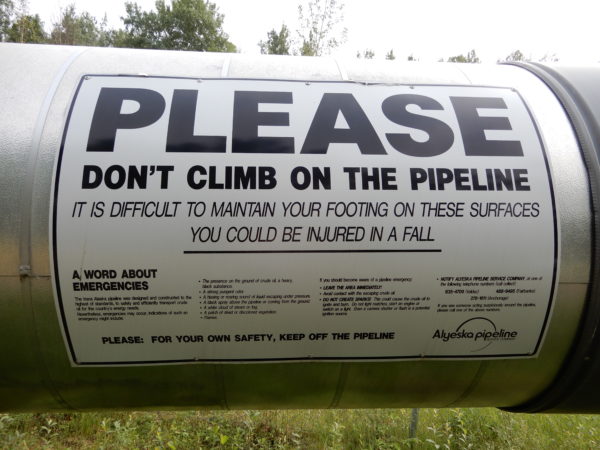
Warning! Danger Will Robinson!
We then boarded a train that took us by exhibits of mining in permafrost and the equipment used.
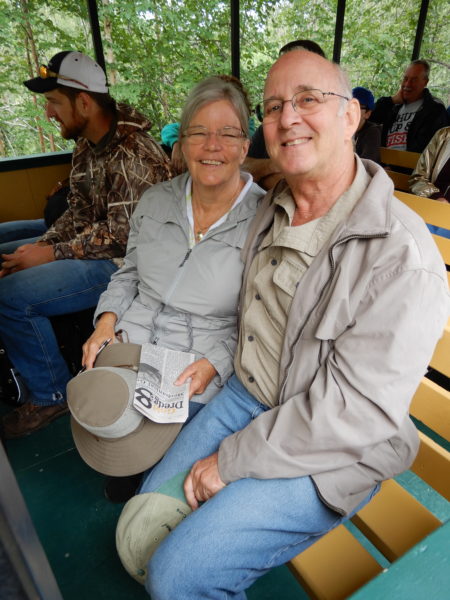
All aboard!
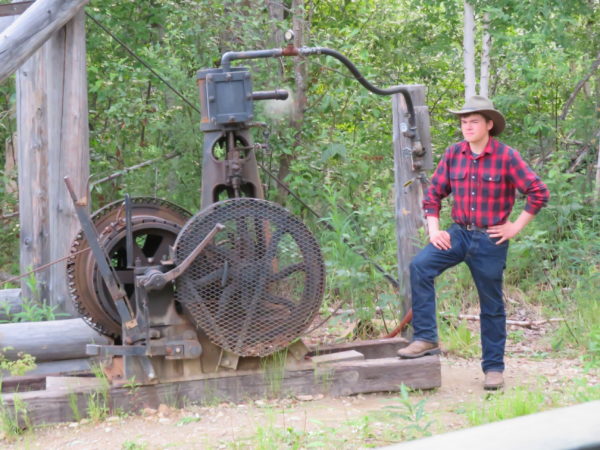
Our conductor was quite an entertainer–telling us stories and serenading is with guitar and fiddle. He wrote the song in the video clip that follows.
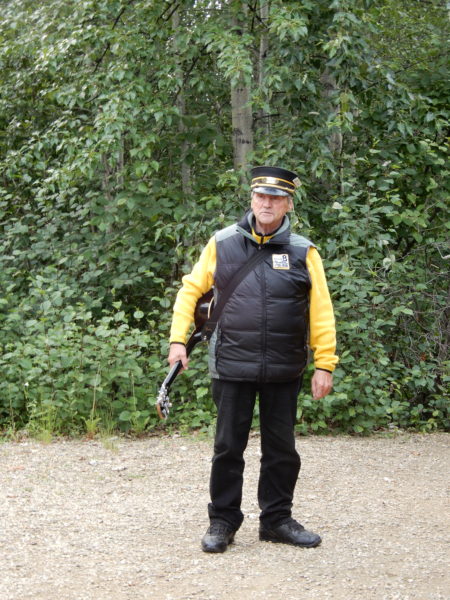
Just before arriving at the dredge, tour employees demonstrated how to pan for gold.
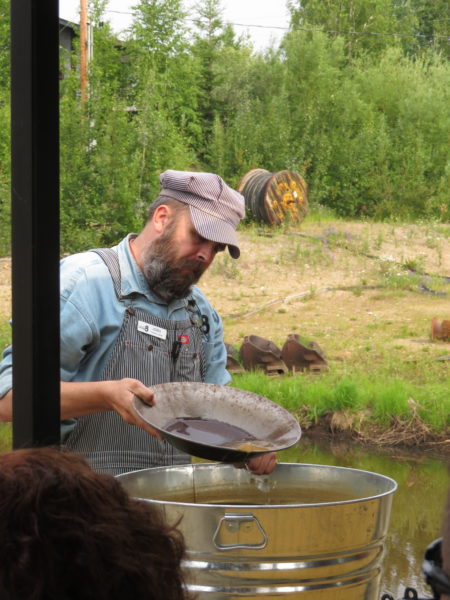
Upon arrival, we were given a bag of “pay dirt” and a pan to try our hand at panning for gold. We did well and after it was weighed we had $30 worth of gold which we put in a locket for Jane to wear.
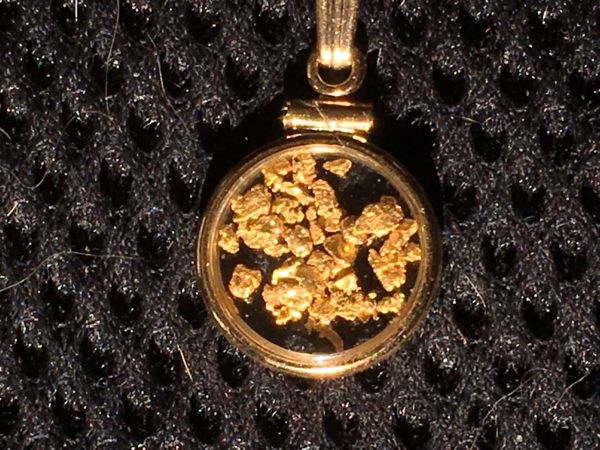
Gold! And we found it ourselves.
We then toured the Dredge and enjoyed hot chocolate and cookies.
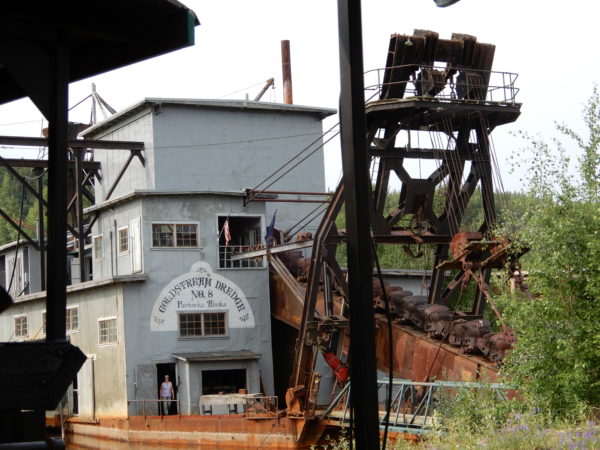
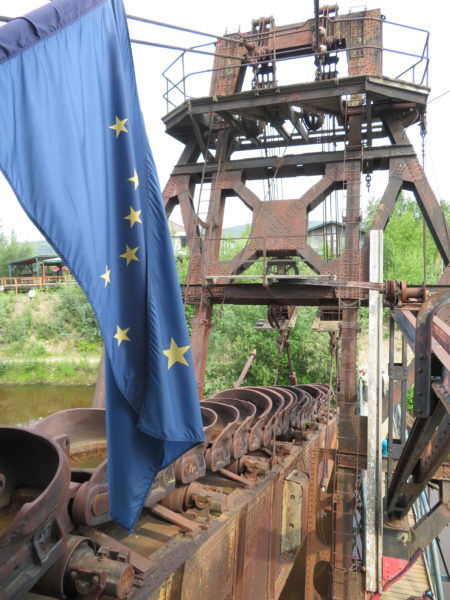

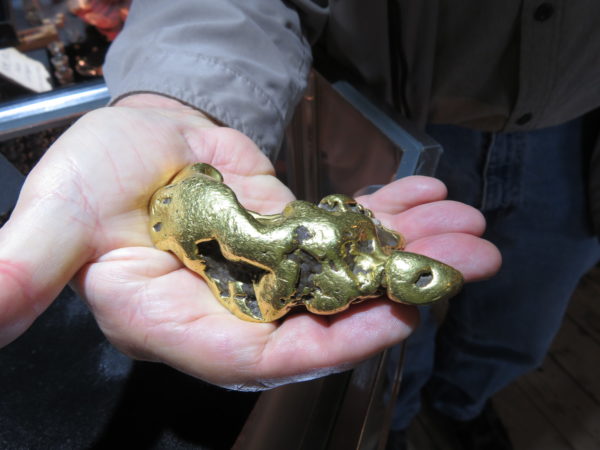
Dave is holding a 19-ounce gold nugget worth more than $75,000.
Back at the campground, we spotted a pair of bald eagles that were nesting across the river. The campground brought in an entertainer who read poetry and told us “Alaska Legends, Tall Tales and Outright Lies” while dressed in period costume.
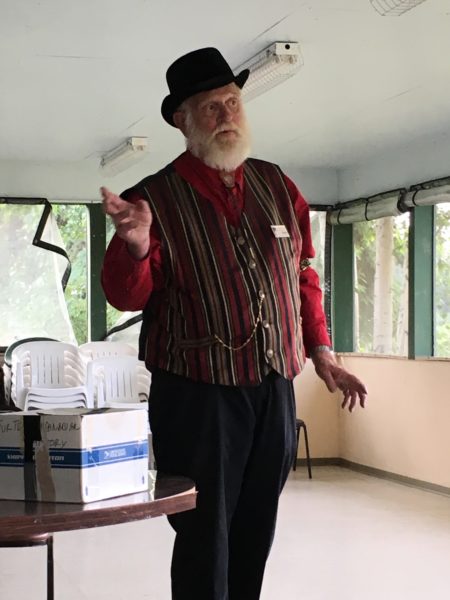
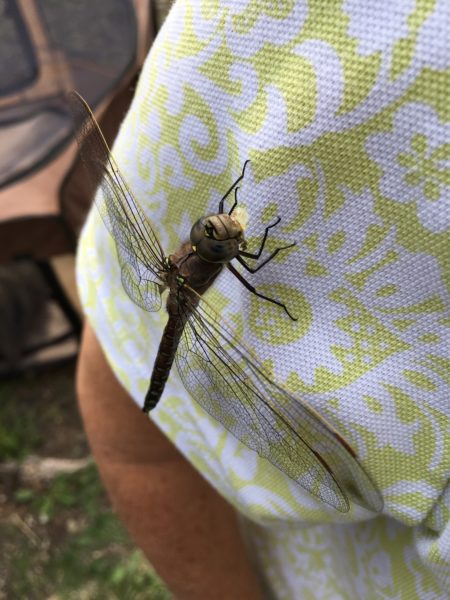
Jane picked up a hitchhiker while sitting outside the coach with the cat.
In North Pole, we couldn’t help noticing what seemed to be a combination liquor store and post office. In fact, the two separate enterprises were accessed through this door.
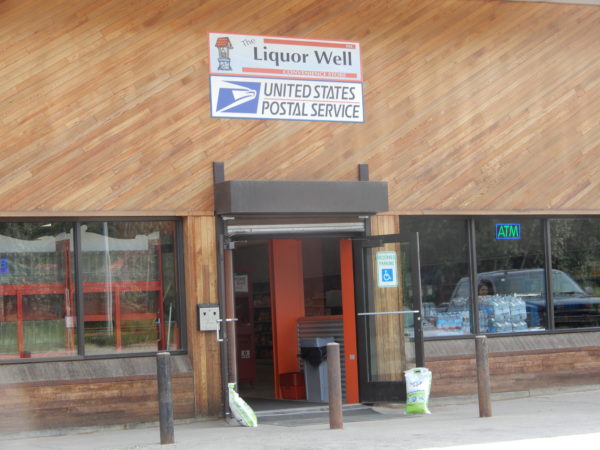
How convenient.

Only in Alaska.
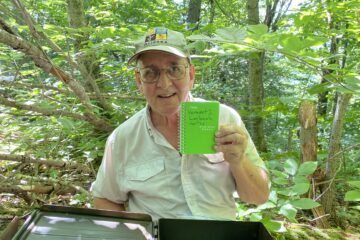
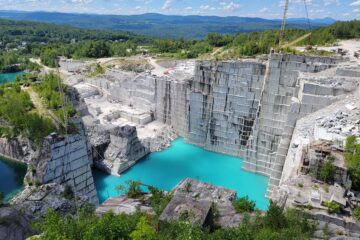
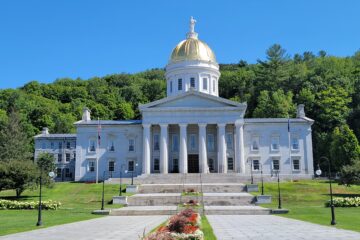
2 Comments
Jay Waters · August 20, 2018 at 9:19 pm
Great trip, and great pix. Thanks for sharing!
Susan · August 25, 2018 at 5:56 pm
Loved reading your story. We enjoyed our time in Fairbanks and Pioneer Park. Great photos